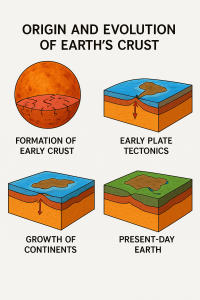
23 Jul Origin And Evolution Of Earth’s Crust
Origin and Evolution of Earth’s Crust – UPSC Geography Optional

Origin And Evolution Of Earth’s Crust
Introduction
The Earth’s crust is the outermost solid shell of our planet and plays a pivotal role in defining the physical landscape we inhabit. Understanding its origin and evolution is fundamental to geomorphology and forms a key topic in Paper 1 of the UPSC CSE Geography Optional syllabus. The Earth’s crust did not exist in its current form at the time of Earth’s formation. It has undergone complex processes, including accretion, differentiation, tectonic activity, and recycling via the rock cycle.
1. Origin of the Earth and Solar System
1.1 Nebular Hypothesis
Proposed by Immanuel Kant and later refined by Laplace, the nebular hypothesis remains the most widely accepted theory for the origin of the Earth and other planetary bodies. According to this model:
- The solar system formed from a rotating cloud of gas and dust (solar nebula) around 4.6 billion years ago.
- Gravitational collapse led to the formation of the Sun at the center and planetesimals in the surrounding disk.
- These planetesimals gradually collided and coalesced to form the Earth.

Origin And Evolution Of Earth’s Crust infographics
2. Accretion and Differentiation
As the Earth grew through accretion, the heat generated by impacts and radioactive decay caused the planet to partially melt.
- Accretion: Infall of cosmic material led to the growth of Earth.
- Differentiation: Heavier elements like iron and nickel sank to form the core, while lighter silicates formed the mantle and crust.
This stratification created the foundational structure of the Earth: core, mantle, and crust. The process set the stage for subsequent crustal evolution.
3. Early Crustal Evolution
The initial crust formed was primarily basaltic (mafic), rich in magnesium and iron, known as the simatic crust. Over time, due to partial melting and tectonic recycling, granitic material (felsic) became more abundant, forming the sialic crust.
3.1 Formation of Protocontinents
The earliest continental nuclei, known as cratons, began to form about 4 billion years ago. These include:
- Shields: Exposed areas of old crystalline rocks (e.g., Canadian Shield, Indian Peninsular Shield).
- Cratons: Stable interiors of continents.
4. Plate Tectonics and Continental Drift
The theory of Plate Tectonics, emerging in the 20th century, revolutionized our understanding of crustal evolution.
4.1 Continental Drift
- Proposed by Alfred Wegener (1912).
- Suggested that all continents were once part of a supercontinent, Pangaea, which later drifted apart.
4.2 Seafloor Spreading and Subduction
- Mid-ocean ridges produce new oceanic crust.
- Subduction zones recycle crust into the mantle.
4.3 Present Crustal Configuration
The Earth’s crust is now divided into major and minor tectonic plates. Their interactions cause earthquakes, mountain formation, and volcanism.
5. Continental Growth and Recycling
The Earth’s continental crust has grown over geological time through:
- Accretion: Addition of material along plate boundaries.
- Collisional Orogeny: Formation of mountains due to continental collisions (e.g., Himalayas).
- Recycling: Crustal material is constantly reworked via erosion, sedimentation, subduction, and magmatism.
6. Role of the Rock Cycle
The rock cycle plays a significant role in transforming crustal material:
- Igneous rocks: Formed from magma/lava.
- Sedimentary rocks: Formed from deposition and lithification.
- Metamorphic rocks: Formed by heat and pressure on pre-existing rocks.
These processes redistribute minerals, contribute to soil formation, and alter the physical structure of the crust.
7. Geological Time Frame of Crustal Evolution
- Hadean (4.6–4.0 Ga): Formation of proto-crust and core.
- Archean (4.0–2.5 Ga): Stabilization of cratons, origin of life.
- Proterozoic (2.5 Ga–541 Ma): Growth of continental crust and oxygenation.
- Phanerozoic (541 Ma–Present): Extensive sedimentation, tectonic activity, and mountain-building events.
8. Previous Year Questions (PYQs)
- 2021: Explain the process of crustal differentiation in Earth’s early history.
- 2019: Discuss the role of plate tectonics in the evolution of continents and oceans.
- 2017: Evaluate the significance of rock cycle in understanding Earth’s crustal evolution.
- 2015: Bring out the role of shield areas in the reconstruction of early crustal history.
9. Probable Questions for UPSC Mains 2025
- Examine the stages of crustal evolution from Hadean to Phanerozoic Eon.
- Discuss the role of endogenic forces in the differentiation of Earth’s interior and crustal formation.
- Evaluate the role of the rock cycle in modifying Earth’s lithosphere.
- How did continental accretion shape the present-day continents?
10. Visual Learning Resources
📊 Download Infographic (PNG)
🧠 Download Mind Map (PNG)
Conclusion
The origin and evolution of the Earth’s crust encapsulate the dynamic history of our planet. From the formation of early cratons to present-day tectonic interactions, the Earth’s surface is a palimpsest of geological processes. A clear understanding of this topic not only builds the foundation for geomorphology but also helps in grasping other topics like plate tectonics, mountain building, and environmental change. With proper diagrams, theory, and examples, this topic can help boost your score in Geography Optional.




No Comments